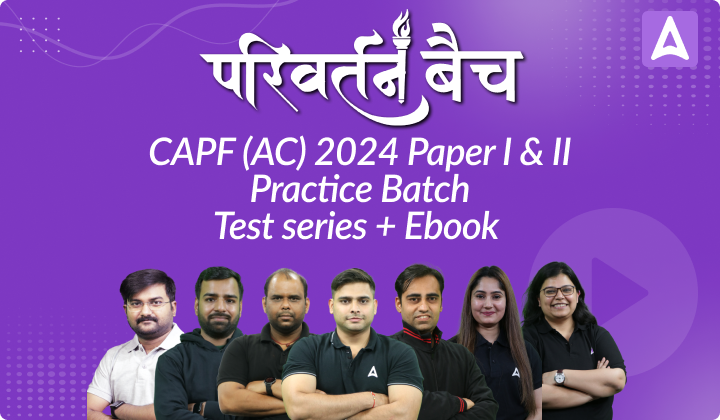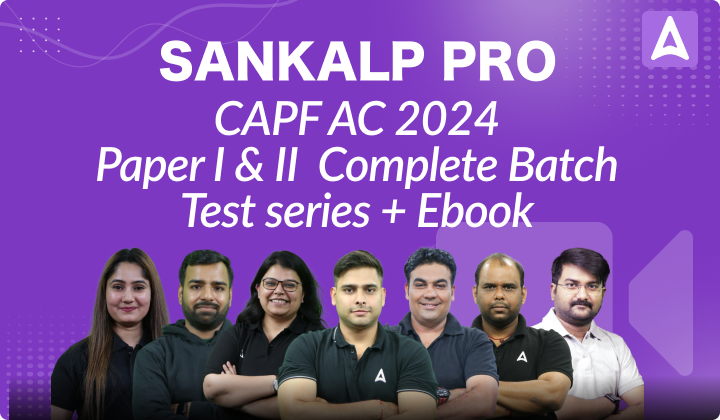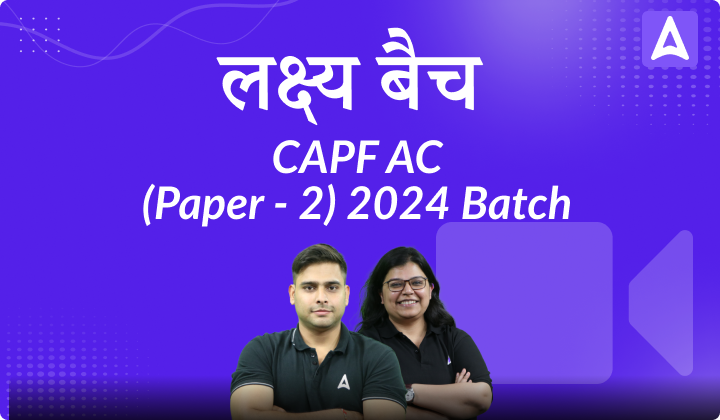The notification for NDA 1 2025 will be released by UPSC in December 2024, with the exam scheduled on 13 April 2025. The General Aptitude Test in the NDA exam consists of a total of 150 questions, which includes sections on both General Knowledge and English. The General Knowledge section, being an important part of the exam, requires candidates to focus on a wide range of topics to score good marks. For NDA General Knowledge questions, candidates are tested on topics such as Indian and world history, geographical concepts, Indian Constitution and government structure. This article will provide information about NDA General Knowledge Questions with Solutions that are asked in the NDA exam.
NDA General Knowledge Questions
The General Knowledge (GK) section of the NDA exam tests candidates on a wide array of subjects essential for a defense career. General Knowledge Questions for NDA cover topics like history, geography, political science, and economics, requiring candidates to understand key events, locations, and basic principles across these fields. Current affairs are also important, assessing awareness of recent global and national developments. Regular practice of NDA General Knowledge questions can help candidates improve recall and speed. Below, we’ll explore the top 20 frequently asked General Knowledge questions in the NDA exam, offering valuable insights for effective preparation.
General Knowledge Questions for UPSC NDA Exam
Q1. Which one of the following statements about lysosomes is NOT correct?
(a) They are waste disposal system of the cel
(b) They breakdown all inorganic materials
(c) These are also referred to as “suicidal bags”
(d) Lysosomes stop entry of foreign materials
Q2. Which of the following two cell organelles have their own genetic material ?
(a) Endoplasmic reticulum and plas- tids
(b) Endoplasmic reticulum and mito- chondria
(c) Mitochondria and plastids
(d) Lysosomes and Golgi apparatus
Q3. Which one among the following tissues help to connect two bones?
(a) Tendons
(b) Ligaments
(c) Areolar tissue
(d) Cartilage
Q4. Which one among the following is the source of energy in cells?
(a) ADP
(b) ATP
(c) AMP
(d) NAD
Q5. In which one among the following the vegetative propagation takes place through Eye Buds?
(a) Potato
(b) Ginger
(c) Onion
(d) Sugarcane
Q6. The intermixing of particles of two different types of matter on their own is called
(a) Osmosis
(b) Brownian motion
(c) Diffusion
(d) Conductance
Q7. Which one among the following separation techniques is used for blood tests in diagnostic laboratories?
(a) Filtration
(b) Chromatography
(c) Centrifugation
(d) Crystallization
Q8. Which one among the following elements is polyatomic ?
(a) Phosphorus
(b) Sulphur
(c) Chlorine
(d) Aluminium
Q9. Which of the following anions has a valency of -3?
(a) Nitride
(b) Nitrate
(c) Sulphide
(d) Sulphate
Q10. The mass of 0-5 mole of N₂ gas is
(a) 7 g
(b) 14 g
(c) 21 g
(d) 28 g
Q11. The chemical reaction:
2AgCl (s)2Ag (s) → Cl₂ (g) takes place
(a) in dark
(b) in sunlight
(c) on heating
(d) under high pressure
Q12. Which one among the following is commonly used as an ‘anti-skinning agent’ in paints?
(a) Gelatin
(b) N-methyl pyrrolidone
(c) Pyridine
(d) Polyhydroxy phenol
Q13. Two resistances of 5-0 Ω and 7-0 Ω are connected in series and the combi- nation is connected in parallel with a resistance of 36-0 Ω. The equivalent resistance of the combination of three resistors is
(a) 24-0 Ω
(b) 12.0 Ω
(c) 9-0 Ω
(d) 6-0 Ω
Q14. Which of the following statements give characteristics of contact forces?
- It appears between an object when it is in contact with some other object
- It satisfies the third law of motion
- It may appear between a pair of solid and fluid
Select the answer using the code given below:
(a) 1 and 3 only
(b) 2 and 3 only
(c) 1 and 2 only
(d) 1, 2 and 3
Q15. Lightning is due to
(a) The flow of charges between different parts of the cloud
(b) The short-circuiting of charges between the upper and lower surfaces of the cloud
(c) The collection of positively charged particles on the base and collection of negatively charged particles at the top of the cloud
(d) The induction of positive charge on the ground below the negative charge at the base of the cloud.
Q16. Given below are the four cases in which certain heat transfer is taking place:
-
- Ice is melting in a glass full of water
- Water is boiling in an open container
- A metal rod is heated in a furnace
- A cup of coffee is allowed to cool on a table
In which of the above cases, the Newton’s Law of Cooling is appli- cable?
(a) 1 only
(b) 4 only
(c) 1 and 4 only
(d) 1, 2 and 3
Q17. Vijayanagara rulers claimed that they were ruling on behalf of
(a) Lord Murugan
(b) Lord Venkateshwara
(c) Shri Virupaksha
(d) Shri Vallabha
Q18. Domingo Paes describes a king in these words: ‘Of medium height, and of fair complexion and good figure, rather fat than thin; he has on his face signs of smallpox’. Identify the king from the options given below.
(a) Krishnadeva Raya
(b) Ram Raya
(c) Devaraya II
(d) Devaraya I
Q19. In which Schedule of the Constitution of India, provisions as to disquali- fication on grounds of defection are given ?
(a) Ninth Schedule
(b) Tenth Schedule
(c) Eleventh Schedule
(d) Sixth Schedule
Q20. Consider the following statements:
- The duties of the Attorney General of India are to give advice to the Government of India upon such legal matters, and to perform such other duties of a legal character, as may from time to time be referred to or assigned to him by the President of India
- The Solicitor General of India is the secondary Law Officer of the country, who assists the Attorney General, and is himself assisted by several Additional Solicitor Generals of India
Which of the statements given above is/are correct?
(a) 1 only
(b) 2 only
(c) Both 1 and 2
(d) Neither 1 nor 2
Solutions
S1.Ans(b)
Sol. The Correct answer is (b) They breakdown all inorganic materials.
Lysosomes are organelles in cells that are responsible for digesting and breaking down organic materials such as proteins, lipids, and carbohydrates. They contain digestive enzymes that help in this process, making them a crucial part of the cell’s waste disposal and recycling system. However, they do not break down inorganic materials, which is why option (b) is incorrect.
Lysosomes are often referred to as “suicidal bags” because they can release their enzymes to digest the cell itself if it is damaged or dying. They also help in removing foreign invaders like bacteria by breaking them down, but they do not stop the entry of foreign materials into the cell.
Information Booster:
- Lysosomes contain around 50 different types of enzymes to digest cellular waste.
• They are primarily responsible for breaking down organic materials, not inorganic.
• The term “suicidal bags” refers to their role in programmed cell death or apoptosis.
• Lysosomes are involved in destroying pathogens like bacteria or viruses through a process called phagocytosis.
• They play a role in recycling cellular components, helping in cell renewal and metabolism.
• Lysosomal malfunction can lead to diseases such as lysosomal storage disorders.
S2.Ans(c)
Sol. The Correct answer is (c) Mitochondria and plastids.
Both mitochondria and plastids (like chloroplasts) have their own genetic material, separate from the DNA found in the cell’s nucleus. These organelles are involved in energy production and photosynthesis, respectively, and their DNA enables them to replicate independently of the cell’s main genetic material. This unique characteristic supports the widely accepted endosymbiotic theory, which suggests that mitochondria and plastids were once free-living organisms that were absorbed by ancient cells.
Information Booster:
- Mitochondria are known as the powerhouses of the cell because they produce energy in the form of ATP.
• Plastids, such as chloroplasts, are found in plant cells and are responsible for photosynthesis.
• Both mitochondria and plastids have double membranes, which is another sign of their evolutionary origin as independent organisms.
• The DNA in these organelles is circular, similar to the DNA found in bacteria.
• Mitochondria and plastids replicate through a process similar to bacterial fission, supporting the theory of their ancient bacterial origins.
• These organelles are passed down maternally, meaning that the mitochondria in your cells are inherited from your mother.
S3. Ans(b)
Sol. The Correct answer is (b) Ligaments.
Ligaments are connective tissues that function to connect two bones at a joint. They are composed of tough, fibrous tissue that helps stabilize joints and guide movement. Ligaments are crucial for maintaining the structural integrity of the skeletal system, ensuring that bones move in a controlled and proper manner.
Information Booster:
- Ligaments are essential for joint stability and preventing excessive movement that could lead to injury.
• Ligaments are slightly elastic, allowing some movement while keeping bones in place.
• Common ligament injuries include sprains, often occurring in areas like the ankle or knee.
• Tendons are different from ligaments in that they attach muscles to bones and assist in movement.
• Ligaments consist mostly of collagen fibers, which give them strength and flexibility.
• Examples include the anterior cruciate ligament (ACL) in the knee, which connects the femur to the tibia.
Tendons connect muscles to bones.
Areolar tissue is a type of loose connective tissue that holds organs in place and provides support to internal structures.
Cartilage is a flexible connective tissue found in joints, ear, nose, and airways, but it does not connect bones directly.
S4. Ans(b)
Sol. The Correct answer is (b) ATP.
Adenosine Triphosphate (ATP) is the primary source of energy in cells. ATP is often referred to as the “energy currency” of the cell because it stores and transports chemical energy within cells for metabolism. When ATP is hydrolyzed (broken down into ADP and a phosphate group), energy is released, which is then used to drive various cellular processes, such as muscle contraction, active transport, and biochemical reactions.
Information Booster:
- ATP stores energy in the high-energy phosphate bonds and releases it when one of these bonds is broken.
• The energy from ATP hydrolysis powers processes like muscle movement, protein synthesis, and active transport.
• ATP is continuously regenerated from ADP during cellular respiration, primarily in the mitochondria.
• ATP is used in almost all forms of life, making it a universal energy carrier.
• The production of ATP mainly occurs through processes like glycolysis, the citric acid cycle, and oxidative phosphorylation.
ADP (Adenosine Diphosphate) is a lower-energy molecule formed when ATP loses a phosphate group.
AMP (Adenosine Monophosphate) is a component of RNA and has even less energy than ADP.
NAD (Nicotinamide Adenine Dinucleotide) is an important coenzyme in redox reactions, involved in energy production, but it does not directly store energy like ATP.
S5.Ans(a)
Sol. The Correct answer is (a) Potato.
Vegetative propagation through eye buds is a characteristic feature of potatoes. The “eyes” on a potato tuber are actually buds, which can sprout and grow into new plants under favorable conditions. Each eye contains the potential to develop into a new shoot, leading to the formation of a new potato plant. This form of vegetative propagation allows farmers to grow potatoes by planting pieces of tuber that contain at least one eye bud.
Information Booster:
- Ginger: Ginger propagates through rhizomes, which are underground stems, not eye buds.
- Onion: Onions propagate through bulbs, which are underground storage organs, not eye buds.
- Sugarcane: Sugarcane propagates through stem cuttings, where buds on the stem nodes develop into new plants, not specifically eye buds.
S6.Ans(c)
Sol. The Correct answer is (c) Diffusion.
Diffusion is the process where particles of two different types of matter intermingle on their own, moving from an area of higher concentration to an area of lower concentration until equilibrium is reached. This happens naturally due to the random motion of particles. Diffusion occurs in gases, liquids, and even solids to some extent. For example, the smell of perfume spreading in a room is a result of diffusion.
Information Booster:
(a) Osmosis: Osmosis is the movement of water or any solvent across a semipermeable membrane from an area of lower solute concentration to an area of higher solute concentration. It is a fundamental process in biology, especially for the movement of water in and out of cells.
(b) Brownian motion: Brownian motion refers to the random movement of particles suspended in a fluid (liquid or gas) resulting from their collision with fast-moving molecules in the fluid. This phenomenon was first observed by Robert Brown and provides evidence for the existence of atoms and molecules.
(d) Conductance: Conductance is a measure of how easily electricity flows through a material. It is the reciprocal of resistance and is measured in siemens (S). Higher conductance indicates a material.
S7.Ans(c)
Sol. The Correct answer is (c) Centrifugation.
Centrifugation is a widely used separation technique in diagnostic laboratories, particularly for blood tests. It works by spinning blood samples at high speeds, creating a centrifugal force that separates the components of blood based on their density. The heavier components, such as red blood cells, move to the bottom, while lighter components, like plasma, remain at the top. This process helps in analyzing different components of blood for diagnostic purposes, such as checking plasma glucose levels, separating blood cells, or detecting abnormalities.
Information Booster:
(a) Filtration: This is a physical method used to separate solids from liquids or gases by passing the mixture through a filter medium that allows only the liquid or gas to pass, while the solid particles are retained. (b) Chromatography: This is a technique used to separate the components of a mixture based on their different affinities for a stationary phase (such as paper or a solid column) and a mobile phase (such as a solvent). It is widely used in chemistry for separating and analyzing complex mixtures.
(d) Crystallization: This is a separation process used to purify substances by forming solid crystals from a solution. It is often used to separate a solid solute from a liquid solvent, as the solute comes out of the solution and forms a crystalline structure when the solvent evaporates.
S8.Ans(b)
Sol. The correct answer is (b) Sulphur.
Sulphur is a polyatomic element because it naturally exists as S₈, meaning a molecule of sulphur consists of eight atoms bonded together in a ring structure. The term “polyatomic” refers to a molecule made up of more than two atoms, and sulphur fits this description.
- Sulphur typically forms S₈ rings, a polyatomic structure.
• It has various allotropes, but the most stable form is the S₈ ring.
• Polyatomic elements contain more than two atoms in their molecular form, making sulphur a clear example.
• Sulphur’s polyatomic nature contributes to its chemical properties and reactivity.
Information Booster:
● Phosphorus: Phosphorus also forms polyatomic molecules, such as P₄, but sulfur is more commonly associated with polyatomic structures in its stable form.
● Chlorine: Chlorine exists as a diatomic molecule (Cl₂), meaning it contains only two atoms.
● Aluminium: Aluminium does not exist as a polyatomic molecule; it is a metallic element and usually forms a lattice structure in its metallic form.
Therefore, Sulphur (S₈) is the correct answer as a polyatomic element.
S9.Ans(a)
Sol. The Correct answer is (a) Nitride.
The nitride anion (N³⁻) has a valency of -3. Nitride is formed when nitrogen gains three electrons to complete its outer electron shell, resulting in a charge of -3. This makes it trivalent, meaning it can combine with three positive charges to form compounds.
Nitrate (NO₃⁻) has a valency of -1.
Sulphide (S²⁻) has a valency of -2.
Sulphate (SO₄²⁻) has a valency of -2.
Information Booster:
- Nitride ions are commonly found in compounds such as aluminum nitride (AlN) and magnesium nitride (Mg₃N₂).
• Nitride compounds are generally quite stable and are often used in materials science due to their hardness and high melting points.
• Nitrides are less common than nitrates and sulfates in nature but have important industrial applications.
• Nitride ions can form ionic compounds with metals, leading to various industrial applications.
S10.Ans(b)
Sol. To calculate the mass of 0.5 mole of N₂ gas, follow these steps:
Determine the molar mass of N₂:
The atomic mass of nitrogen (N) is approximately 14 g/mol.
Since N₂ has two nitrogen atoms:
Molar mass of N₂ = 14 g/mol × 2 = 28 g/mol.
Calculate the mass of 0.5 mole:
Mass = Moles × Molar Mass
Mass = 0.5 mole × 28 g/mol = 14 g.
The correct answer is (b) 14 g.
S11.Ans(b)
Sol. The Correct answer is (b) in sunlight.
The reaction 2AgCl (s) → 2Ag (s) + Cl₂ (g) involves the decomposition of silver chloride (AgCl) into silver (Ag) and chlorine gas (Cl₂). This reaction takes place when silver chloride is exposed to sunlight. The sunlight provides the energy needed to break the bonds in AgCl, causing it to decompose. This is an example of a photochemical reaction, which occurs in the presence of light.
Information Booster:
This reaction demonstrates the photolytic decomposition of silver chloride.
When exposed to sunlight, the white color of AgCl slowly turns gray due to the formation of metallic silver.
This reaction is often used in photographic films where light exposure leads to image development.
The decomposition of AgCl is a key concept in photochemistry and the study of light-induced chemical reactions.
S12.Ans(d)
Sol. The Correct answer is (d) Polyhydroxy phenol.
Polyhydroxy phenol is commonly used as an anti-skinning agent in paints. Anti-skinning agents are additives used in paints and coatings to prevent the formation of a skin or film on the surface of the paint when it is exposed to air. This skin forms due to the oxidation of certain components in the paint, which can hinder its application and affect the quality of the coating.
Polyhydroxy phenol works by inhibiting the oxidative polymerization process, thus keeping the paint fluid and free from surface skin during storage.
Information Booster:
- Anti-skinning agents like polyhydroxy phenol help improve the shelf life and usability of paints, especially oil-based paints.
- They are particularly important in preventing skin formation during the drying process in the presence of oxygen.
- This ensures that the paint remains easy to apply and maintains its desired finish.
- Other common anti-skinning agents include methyl ethyl ketoxime and butylated hydroxytoluene (BHT).
S13.Ans(c)
Sol. The correct answer is (c) 9-0 Ω.
Here’s the step-by-step solution:
- Resistances in Series:
When resistances are connected in series, their equivalent resistance is simply the sum of the resistances. In this case, the two resistances are 5 Ω and 7 Ω, so:
Equivalent resistance in series = 5 Ω + 7 Ω = 12 Ω.
- Combination with Parallel Resistance:
Now, the 12 Ω resistance (from the series combination) is connected in parallel with a 36 Ω resistance. The formula to calculate the equivalent resistance ReqR_{\text{eq}}Req for two resistors in parallel is:
1/Rₑ = 1/R₁ + 1/R₂.
Substituting the values, we get:
1/Rₑ = 1/12 + 1/36.
Simplifying this:
1/Rₑ = (3 + 1)/36 = 4/36 = 1/9.
Therefore, Rₑ = 9 Ω.
Thus, the equivalent resistance of the combination of resistors is 9 Ω.
Information Booster:
● Series combination: The total resistance increases as you add the resistances together.
● Parallel combination: The total resistance decreases, and the equivalent resistance is always less than the smallest resistor.
● Practical usage: Understanding series and parallel combinations is essential for designing electrical circuits to control the flow of current.
S14.Ans(d)
Sol. The Correct answer is (d) 1, 2 and 3.
Explanation:
It appears between an object when it is in contact with some other object:
This is correct. Contact forces arise when two objects physically touch each other. Examples include frictional forces, normal forces, and tension in ropes or springs.
It satisfies the third law of motion:
This is also correct. According to Newton’s Third Law of Motion, for every action, there is an equal and opposite reaction. Contact forces adhere to this law; for example, when you push on a wall, the wall pushes back with an equal and opposite force.
It may appear between a pair of solid and fluid:
This is also correct. Contact forces can occur between solids and fluids. For example, the buoyant force is a contact force exerted by a fluid on a solid object submerged in it, and drag is a contact force acting on an object moving through a fluid.
Information Booster:
Contact forces require physical contact between two objects, as opposed to non-contact forces like gravitational or electromagnetic forces.
Friction, tension, normal forces, and air resistance are common examples of contact forces.
In fluids, forces like buoyancy and viscous drag are contact forces that arise when a solid object interacts with the fluid.
S15.Ans(d)
Sol. The correct answer is (d) The induction of positive charge on the ground below the negative charge at the base of the cloud.
Explanation:
Lightning is a result of the separation of charges within a cloud. The upper parts of a thundercloud generally carry positive charges, while the lower parts accumulate negative charges. When the charge separation becomes large enough, the negative charge at the cloud’s base induces a positive charge on the ground directly beneath it. This induction of charge on the ground creates a strong electric field. Once this electric field becomes sufficiently strong to overcome the resistance of the air, it results in a lightning discharge that neutralizes the charge difference between the cloud and the ground, or within different parts of the cloud.
Thus, the correct explanation is related to the induction of positive charge on the ground beneath the negatively charged base of the cloud, which triggers the lightning strike.
S16.Ans(b)
Sol. The correct answer is (b) 4 only.
Explanation:
Newton’s Law of Cooling applies when an object cools by losing heat to its surrounding environment. The law states that the rate of heat loss of an object is proportional to the temperature difference between the object and its surroundings. This situation matches Case 4, where a cup of coffee is cooling on a table. The coffee loses heat to the cooler surrounding air, and the cooling rate depends on the temperature difference between the coffee and the air.
Analysis of Other Cases:
- Case 1 (Ice melting): Involves heat absorption, not heat loss, so Newton’s Law of Cooling doesn’t apply.
- Case 2 (Boiling water): Involves constant heat input to maintain boiling, which doesn’t fit Newton’s Law.
- Case 3 (Heating a metal rod): Involves heat gain rather than loss, so it doesn’t apply here.
Therefore, Newton’s Law of Cooling is applicable only to Case 4.
S17.Ans(c )
Sol. The correct answer is (c) Shri Virupaksha.
Explanation:
The Vijayanagara rulers claimed to be ruling on behalf of Lord Virupaksha, a form of Lord Shiva, who was the chief deity worshipped by the empire. The Virupaksha Temple in Hampi served as a religious and cultural center, symbolizing their divine right to rule.
Information Booster:
Vijayanagara Dynasty
- Founded by Harihara I and Bukka Raya I in 1336.
● Capital: Hampi, now a UNESCO World Heritage Site.
● Notable Ruler: Krishnadevaraya, who led a golden era of art and literature.
● Religious Tolerance: Promoted coexistence of different faiths.
● Battle of Talikota (1565): Led to the empire’s decline after a defeat by Deccan Sultanates.
● Architecture: Known for grand temples like Vitthala Temple and Hazara Rama Temple in Hampi.
S18.Ans(a)
Sol. The correct answer is (a) Krishnadeva Raya.
Explanation:
Domingo Paes, a Portuguese traveler, visited the Vijayanagara Empire during the reign of Krishnadeva Raya and documented his observations. He described Krishnadeva Raya as being of medium height, fair complexion, with a robust build, and showing signs of smallpox on his face. Krishnadeva Raya ruled the Vijayanagara Empire from 1509 to 1529 and is often regarded as one of its greatest rulers, celebrated for his military achievements and support of arts and literature.
Information Booster:
Krishnadeva Raya
- Reign: Ruled from 1509-1529 and expanded the empire’s territories significantly.
● Cultural Patron: Encouraged literature in Kannada, Telugu, and Sanskrit, and was a patron of poets like Allasani Peddana.
● Military Achievements: Known for his strategic skills in battles, especially against the Bahmani Sultanate.
● Architectural Contributions: Built iconic structures, including parts of the Vitthala Temple in Hampi.
● Administration: Implemented efficient administration and tax reforms, promoting prosperity within his empire.
S19.Ans(b)
The correct answer is (b) Tenth Schedule.
Explanation:
The Tenth Schedule of the Indian Constitution, also known as the “Anti-Defection Law,” was added by the 52nd Amendment Act in 1985. It lays down the provisions related to disqualification of members of Parliament and State Legislatures on the grounds of defection. Under this law, legislators can be disqualified if they voluntarily give up membership of their party or disobey the directives of their party on votes, commonly referred to as “crossing the floor.”
Information Booster:
- Ninth Schedule: Added by the First Amendment Act of 1951, this schedule was created to protect certain laws, primarily related to land reforms and social justice, from judicial review. Laws placed under this schedule were initially immune from being challenged in courts; however, in 2007, the Supreme Court ruled that laws under this schedule could still be reviewed if they violate the basic structure of the Constitution.
- Eleventh Schedule: Introduced by the 73rd Amendment Act of 1992, this schedule specifies the powers, authority, and responsibilities of Panchayats. It includes 29 subjects, such as agriculture, education, health, and rural development, that local governments can manage to promote grassroots democracy and local self-governance.
- Sixth Schedule: This schedule deals with the administration of tribal areas in Assam, Meghalaya, Tripura, and Mizoram. It provides for the creation of Autonomous District Councils and Regional Councils to allow greater self-governance for indigenous communities. These councils have legislative, judicial, and executive powers within their jurisdiction, aiming to protect the cultural heritage and rights of tribal populations.
S20.Ans(c )
Sol. The correct answer is (c) Both 1 and 2.
- Statement 1 is correct: The Attorney General of India is appointed under Article 76 of the Constitution. His duties include giving advice to the Government of India on legal matters and performing other duties assigned by the President of India.
- Statement 2 is correct: The Solicitor General of India is the second-highest law officer in the country, assisting the Attorney General. The Solicitor General is also supported by several Additional Solicitors General.
Information Booster:
- Attorney General: Appointed under Article 76, the Attorney General advises the government and represents it in the Supreme Court.
● Solicitor General: Assists the Attorney General and is supported by Additional Solicitors General. This is not a constitutional post but is appointed to aid in legal matters.
● Article 88: Allows the Attorney General to attend and participate in Parliament but without voting rights.
● Tenure: Both the Attorney General and Solicitor General hold office at the pleasure of the President, meaning they can be removed without a fixed tenure.
NDA G.K Questions PDF
To access all these questions in PDF format, simply download the NDA English Questions PDF using the link provided below. Candidates can quickly obtain it by clicking the link.
Click Here to download NDA GK Questions PDF
In conclusion, practicing NDA general knowledge questions is one of the best ways to prepare effectively for the exam. These questions cover important topics such as history, geography, politics, and current events, helping candidates strengthen their knowledge in areas required for a defense career. Regular practice not only improves understanding but also boosts confidence and memory during the exam.
| Related Articles | |
| NDA 1 2025 | |
| NDA Exam Date 2025 |
NDA Syllabus |
| NDA Cut Off | NDA Previous Year Questions |
| How to Prepare for NDA 2025? | NDA General Ability Previous Year Papers |

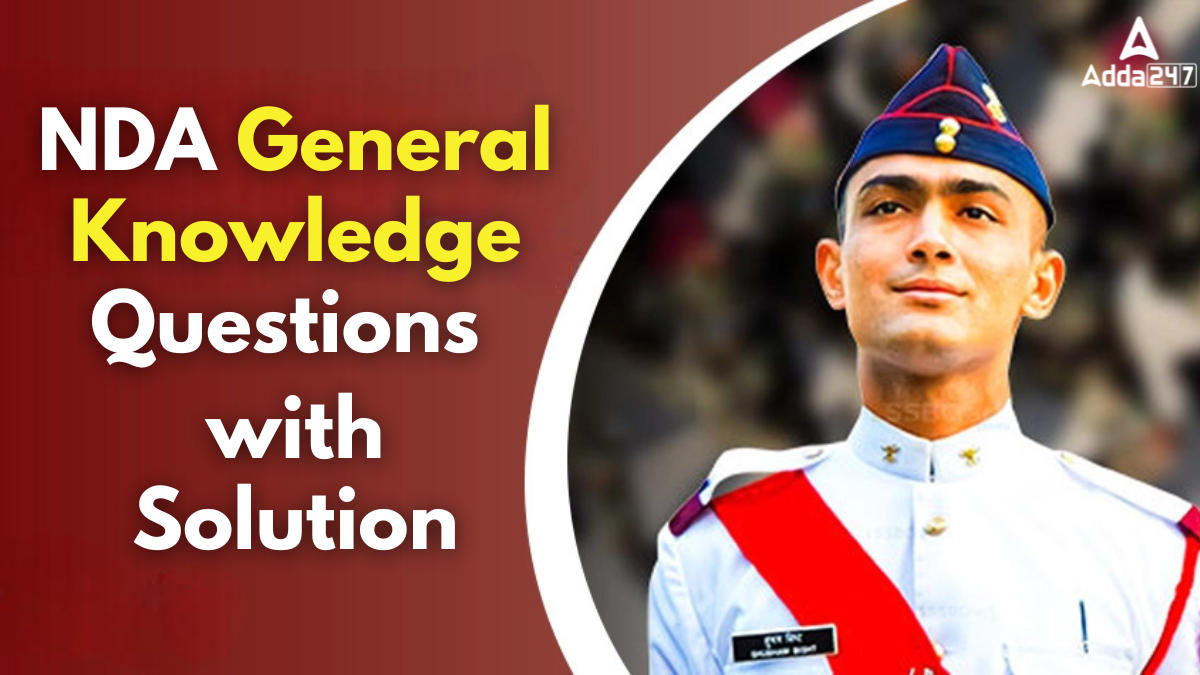


 CDS Previous Year Question Papers, Downl...
CDS Previous Year Question Papers, Downl...
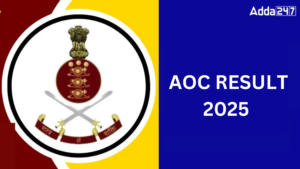 AOC Result 2025 Out, Download Link Activ...
AOC Result 2025 Out, Download Link Activ...
 NDA 1 Admit Card 2025 Out, Download NDA ...
NDA 1 Admit Card 2025 Out, Download NDA ...







